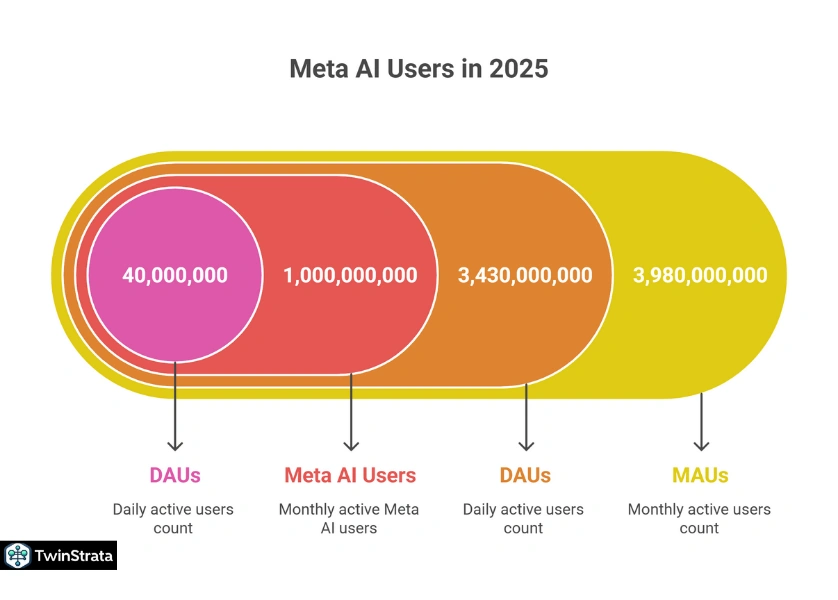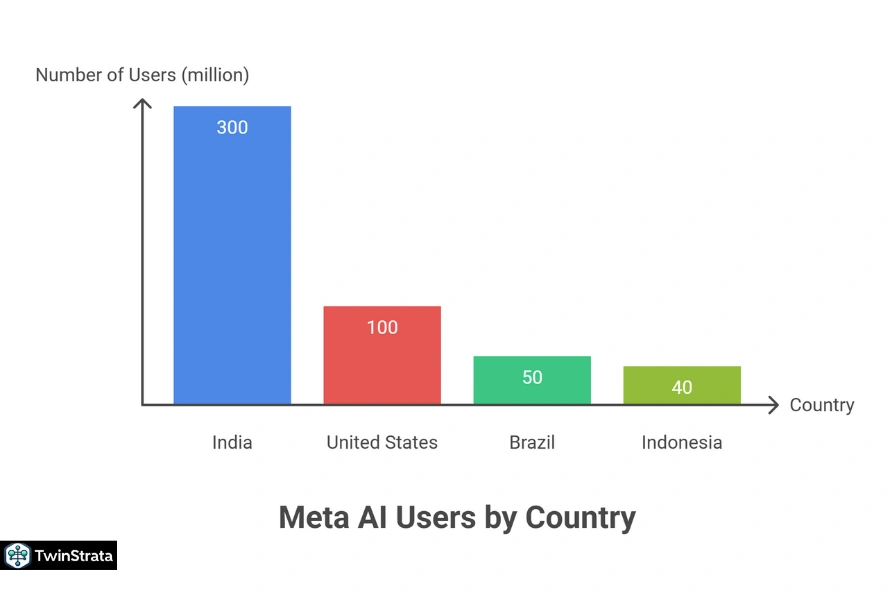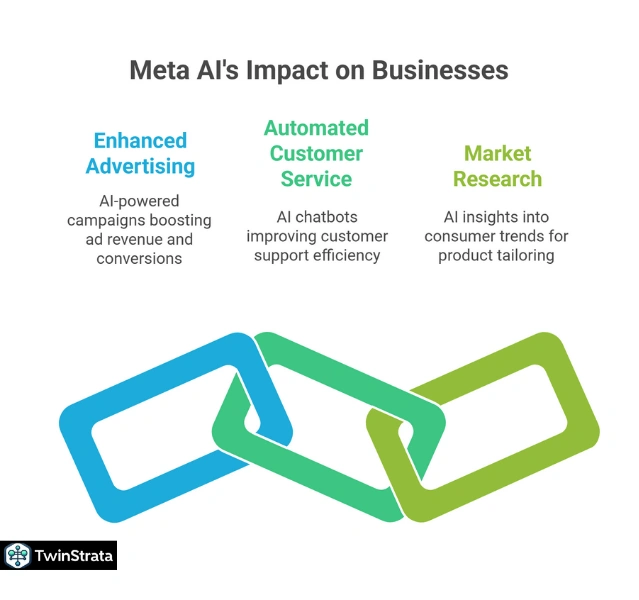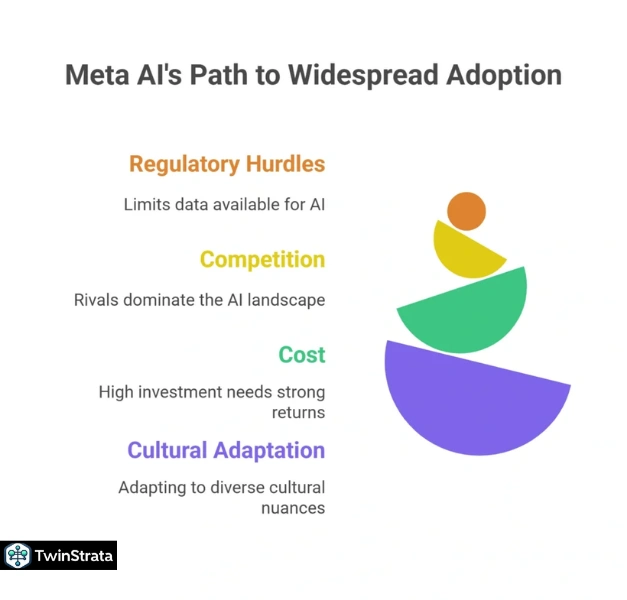Meta AI has transformed how people interact with technology in 2025, reaching an astonishing 1 billion monthly active users (MAUs) across its platforms.
Launched on September 27, 2023, with the second-generation Ray-Ban Meta Smart Glasses, Meta AI has seamlessly integrated into Meta’s ecosystem of apps—Facebook, Instagram, WhatsApp, and Messenger—driving explosive growth.
With 40 million daily active users and 185 million weekly active users, Meta AI is now the second-largest AI assistant globally, trailing only ChatGPT.
This article dives into the latest Meta AI users statistics 2025, explores its global reach, and provides actionable insights for businesses, marketers, and individuals to harness its potential.
We’ve also incorporated fresh insights from Quora and Reddit to capture what users are saying, ensuring you have the most up-to-date information.
Whether you’re a business owner, a marketer, or a curious user, this guide will help you understand Meta AI’s massive user base and how to use it to your advantage.
Table of Contents
ToggleMeta AI Users Statistics 2025: A Snapshot

Meta AI’s growth in 2025 is nothing short of remarkable. Below is a quick overview of key statistics that highlight its scale and impact:
| Metric | Value |
| Monthly Active Users (MAUs) | 1 billion |
| Daily Active Users (DAUs) | 40 million |
| Weekly Active Users (WAUs) | 185 million |
| Countries Available | 48 |
| Languages Supported | 8 (English, French, German, Hindi, Hindi-Romanized, Italian, Portuguese, Spanish) |
| Market Share (AI Chatbot) | 15–20% |
| Top Market | India (300 million users) |
Source: Statista, The Information
These numbers reflect Meta AI’s rapid adoption, fueled by its integration into Meta’s Family of Apps, which collectively boast 3.98 billion MAUs and 3.43 billion daily active users (DAUs).
With roughly one in four Meta users interacting with AI features, Meta AI has become a cornerstone of the company’s ecosystem.
The Rise of Meta AI: A Historical Perspective
Meta AI’s journey to 1 billion MAUs is a testament to its strategic integration and rapid scaling. Here’s a timeline of its user growth:
| Time Period | Monthly Active Users (MAUs) | Source Context |
| Late 2023 | 100 million | Initial rollout in Ray-Ban Meta Glasses |
| Mid 2024 | 400 million | Expanded integration in Meta apps |
| Late 2024 | 500 million | DemandSage, AI Magazine reports |
| January 2025 | 700 million | EasyEquities, THE Journal reports |
| Q1 2025 | Nearly 1 billion | Meta Q1 2025 Earnings Report |
Meta AI’s growth from 100 million MAUs in late 2023 to nearly 1 billion by Q1 2025 showcases its meteoric rise.
CEO Mark Zuckerberg announced this milestone during Meta’s Q1 2025 earnings call, stating, “We’re making good progress on AI glasses and Meta AI, which now has almost 1 billion monthly active users.”
This growth outpaces competitors like Google’s Gemini (400 million MAUs) and positions Meta AI as a close rival to ChatGPT, which reported 800 million weekly active users in 2025.
What Drives Meta AI’s Growth?
Several factors have propelled Meta AI to this milestone:
- Seamless Integration: Meta AI is embedded in the search bars, chat interfaces, and content creation tools of Facebook, Instagram, WhatsApp, and Messenger. This makes it easy for users to access AI without downloading a new app.
- Massive User Base: Meta’s Family of Apps, with 3.98 billion MAUs, provides a built-in audience for AI adoption.
- Feature Expansion: Features like image generation, content summarization, and real-time assistance via Ray-Ban Meta Smart Glasses keep users engaged.
- Geographic Expansion: From 22 countries in 2024 to 48 countries in 2025, Meta AI’s global rollout has broadened its reach, with India leading as the largest market.
- Standalone App Launch: In April 2025, Meta launched a dedicated Meta AI app powered by Llama 4, offering advanced features and attracting new users.
Also read about: Grok AI Statistics
Who Uses Meta AI? Demographics and Regional Insights

While Meta hasn’t released detailed demographics specific to Meta AI, we can infer trends based on its integration into Meta’s platforms and regional rollout data.
Demographic Trends
- Age Distribution: Meta AI usage likely mirrors the demographics of its host platforms. Instagram attracts younger users (Gen Z and Millennials, aged 18–34), while Facebook has a broader age range, including older users (35–54). WhatsApp spans all age groups, especially in regions like India and Brazil.
- Gender Split: Based on Meta’s Family of Apps, approximately 52% of users are male, and 47% are female, suggesting a similar split for Meta AI users.
- Business Users: Over 4 million advertisers use Meta AI’s generative tools for ad creation, indicating strong adoption among businesses, particularly small and medium-sized enterprises (SMEs).
Regional Breakdown
Meta AI is available in 48 countries, with significant adoption in key markets:
| Country | Estimated Meta AI Users | Platform Strength |
| India | 300 million | WhatsApp (535 million MAUs), Instagram (413 million MAUs) |
| United States | 100 million | Facebook (308 million MAUs), Instagram (171 million MAUs) |
| Brazil | 50 million | WhatsApp (3 billion global MAUs), Instagram (140 million MAUs) |
| Indonesia | 40 million | WhatsApp, Instagram |
| Mexico | 30 million | WhatsApp, Facebook |
- India: With 300 million Meta AI users, India is the largest market, driven by WhatsApp’s 535 million MAUs and Instagram’s 413 million MAUs. Users in India leverage Meta AI for tasks like language translation and local business searches.
- United States: The U.S. accounts for 100 million Meta AI users, with strong adoption in advertising and business intelligence. Companies like TEKsystems and Cisco Systems use Meta AI for analytics.
- Brazil and Indonesia: These markets show robust growth due to high WhatsApp and Instagram penetration, though Brazil’s data privacy regulations have posed challenges.
Also read about: Semrush AI Statistics
Insights from Quora and Reddit
Users on Quora and Reddit are buzzing about Meta AI’s growth and its implications:
- Quora: Users frequently ask, “How is Meta AI competing with ChatGPT?” Answers highlight Meta AI’s advantage of being integrated into apps billions already use, unlike ChatGPT’s standalone model. One user noted, “Meta AI feels like a natural part of WhatsApp, making it easier to adopt than visiting a new site.”
- Reddit: Discussions in subreddits like r/technology focus on privacy concerns, with users debating Meta’s use of public data for AI training. One thread emphasized, “Meta AI’s growth is impressive, but I’m worried about how my data is used.” Others praise its utility, with comments like, “I use Meta AI on WhatsApp to plan group trips—it’s a game-changer.”
- Emerging Use Cases: Reddit users highlight Meta AI’s role in education, with students using it for homework help and language learning, especially in Hindi and Spanish-speaking regions. Quora threads mention businesses using Meta AI for automated customer service, with one user stating, “It’s saving my small business hours on customer queries.”
These discussions reveal a mix of excitement and caution, with users valuing Meta AI’s convenience but seeking clarity on privacy and data usage.
Meta AI’s Market Share and Competitive Landscape
Meta AI holds an estimated 15–20% share of the global AI chatbot market in 2025, trailing ChatGPT’s 60.5% but ahead of Google’s Gemini (10%) and other competitors like Microsoft’s Copilot and Anthropic’s Claude. Here’s a comparison:
| AI Assistant | Market Share | Monthly Active Users |
| ChatGPT | 60.5% | 800 million (weekly) |
| Meta AI | 15–20% | 1 billion |
| Gemini | 10% | 400 million |
| Copilot | 5% | Not disclosed |
| Claude | 3% | Not disclosed |
Meta AI’s competitive edge lies in its integration into Meta’s apps, giving it access to a massive, pre-existing user base. Unlike ChatGPT, which requires users to visit a website or download an app, Meta AI is available where users already spend time. However, competitors like ChatGPT lead in advanced reasoning tasks, while Google’s Gemini benefits from its search engine dominance.
How Meta AI Impacts Businesses and Users

Meta AI’s growth isn’t just about numbers—it’s reshaping how businesses and individuals interact online. Here’s how you can leverage Meta AI for your benefit:
For Businesses
- Enhanced Advertising:
- Meta AI powers Advantage+ campaigns, which generate $20 billion annually and improve ad conversions by 5% on Reels. Businesses can use AI to create personalized ad variants and target audiences more effectively.
- Example: A small e-commerce store can use Meta AI to generate ad visuals and test them across Instagram and Facebook, saving time and boosting ROI.
- Automated Customer Service:
- Over 38 companies, including TEKsystems and Deere & Company, use Meta AI for business intelligence and customer support. AI chatbots on WhatsApp handle queries, reducing response times.
- Example: A restaurant can set up a Meta AI chatbot on WhatsApp to answer menu questions or take reservations, freeing up staff.
- Market Research:
- Meta AI analyzes user interactions to provide insights into consumer trends. Businesses can use these to tailor products or services.
- Example: A fashion brand can analyze Instagram comments via Meta AI to identify trending styles and adjust inventory.
For Individuals
- Conversational Assistance:
- Meta AI helps with tasks like planning events, answering questions, or generating creative content within WhatsApp, Instagram, or Messenger.
- Example: Plan a group trip by asking Meta AI for itinerary suggestions in a WhatsApp group chat.
- Creative Tools:
- Users can create custom stickers, edit photos, or generate images from text prompts, enhancing social media posts.
- Example: Turn a text description into a unique Instagram sticker to make your Stories stand out.
- Real-Time Information:
- Via Ray-Ban Meta Smart Glasses, users access hands-free information, such as directions or translations.
- Example: A traveler in Japan can use Meta AI on smart glasses to translate signs in real-time.
For Marketers
- Content Optimization:
- Meta AI summarizes long threads or group discussions, helping marketers craft targeted content.
- Example: Summarize a Facebook Group discussion to create a post that resonates with your audience.
- SEO and Engagement:
- Use Meta AI to generate keyword-rich captions or analyze trending topics on Instagram and Facebook.
- Example: A marketer can ask Meta AI to suggest hashtags for a campaign, increasing post visibility.
Llama: The Engine Behind Meta AI
Meta AI is powered by the Llama series, particularly Llama 3 and Llama 4, which are open-source models driving innovation. Key features include:
- Llama 3 Models:
- 8B: Efficient for on-device tasks like mobile apps.
- 70B: Balances performance and resource needs for business applications.
- 405B: Competes with top models like GPT-4 for complex tasks.
- Downloads: Llama models have been downloaded 350 million times, with 20 million downloads in August 2024 alone.
- Training: Llama 3 was trained on 15 trillion tokens, using over 16,000 NVIDIA H100 GPUs.
| Model | Parameters | Best For | Hardware Needs |
| Llama 3 8B | 8 billion | On-device tasks | Consumer-level |
| Llama 3 70B | 70 billion | Business applications | Multiple GPUs/Cloud |
| Llama 3.1 405B | 405 billion | Advanced research, complex tasks | Significant infrastructure |
The open-source approach has spurred adoption, with organizations like Spotify and LinkedIn using Llama for personalized recommendations and efficient training.
Challenges and Future Outlook

Despite its success, Meta AI faces challenges:
- Regulatory Hurdles: Brazil’s ban on Meta using personal data for AI training highlights privacy concerns. The EU’s Digital Markets Act may limit data usage, impacting growth.
- Competition: ChatGPT’s 800 million weekly users and Google’s search dominance pose threats. Meta must innovate to stay competitive.
- Cost: Meta’s $64–72 billion investment in AI infrastructure for 2025 is substantial, requiring strong returns.
- Cultural Adaptation: In markets like India, Meta AI faces challenges adapting to diverse languages and cultural nuances.
Looking ahead, Meta plans to:
- Expand to more countries, potentially reaching 1.5 billion MAUs by 2026.
- Launch premium AI tiers for advanced tasks, as hinted by Zuckerberg.
- Deepen integration with hardware like next-gen smart glasses and the Metaverse.
Leveraging Meta AI: Practical Tips
To make the most of Meta AI’s 1 billion users, consider these strategies:
- Optimize for WhatsApp: With 3.14 billion MAUs, WhatsApp is a prime channel for businesses. Use Meta AI to automate customer support or send personalized offers.
- Target India: India’s 300 million Meta AI users offer a massive audience. Localize content in Hindi or other regional languages.
- Use AI for Ads: Leverage Meta AI’s generative tools to create high-converting ads, especially on Instagram Reels, which see 138.9 million plays per minute.
- Engage on Social Media: Monitor Quora and Reddit for user feedback to refine your AI-driven campaigns.
- Experiment with Smart Glasses: For tech-savvy audiences, promote products via Meta AI’s hands-free features on Ray-Ban Meta Smart Glasses.
FAQs About Meta AI Statistics
1. How many people use Meta AI in 2025?
Meta AI has 1 billion monthly active users as of Q1 2025, with 40 million daily active users and 185 million weekly active users. This growth reflects its integration into Meta’s apps like WhatsApp, Instagram, and Facebook.
2. Which countries have the most Meta AI users?
India leads with 300 million users, followed by the United States with 100 million. Other key markets include Brazil, Indonesia, and Mexico, where WhatsApp and Instagram drive adoption.
3. How can businesses benefit from Meta AI?
Businesses can use Meta AI for automated customer service, personalized advertising, and market research. For example, AI-driven Advantage+ campaigns generate $20 billion annually, and chatbots on WhatsApp streamline customer interactions.
4. What makes Meta AI different from ChatGPT?
Meta AI is integrated into Meta’s apps (Facebook, Instagram, WhatsApp), making it more accessible than ChatGPT, which requires a separate app or website. Meta AI also leverages Llama’s open-source models, fostering broader innovation.
5. Are there privacy concerns with Meta AI?
Yes, privacy concerns exist, especially after Brazil banned Meta from using personal data for AI training. Users on Reddit express worries about data security, but Meta emphasizes using only public data for training.
Also Read:
- SEO Statistics
- Link Building Statistics
- Facebook Statistics
- Voice Search Statistics
- YouTube Statistics
Conclusion:
In conclusion, Meta AI’s impressive growth to 1 billion monthly active users in 2025 highlights its significant impact on businesses, marketers, and everyday users.
With its seamless integration into Meta’s vast ecosystem of apps like Facebook, Instagram, WhatsApp, and Messenger, Meta AI is transforming how people interact with technology.
While challenges such as privacy concerns and competition remain, the platform’s continued expansion and innovative features offer vast opportunities for engagement and business success. As Meta AI evolves, its potential to shape the future of digital interaction is undeniable.
